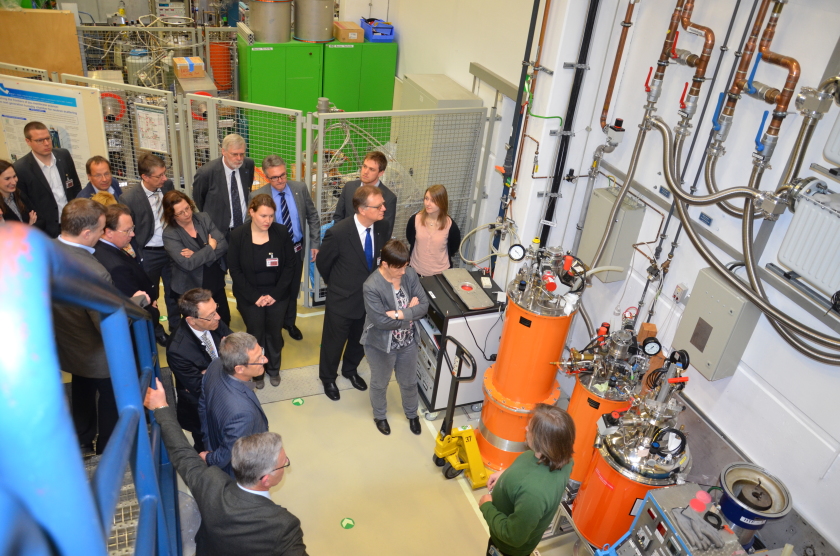Deutsche Gesellschaft für Materialkunde was a guest of HZB

Tour through the experimental hall of BER II.
From 15 to 16 March, the Deutsche Gesellschaft für Materialkunde, DGM (German association of materials science), held its closed board meeting and Advisory Council meeting at HZB. The experts took the occasion to visit the synchrotron source BESSY II and the neutron source BER II, gaining an insight into important future projects of HZB.
“It was a great pleasure to be host to the Deutsche Gesellschaft für Materialkunde, where we had the opportunity to present Helmholtz-Zentrum Berlin’s strategies and research infrastructures, which external researchers are also very welcome to use,“ says Prof. Dr. Anke Kaysser-Pyzalla, scientific director of HZB.
The board members of the DGM visited the control room and experimental hall of BESSY II on 15 March. On 16 March, the DGM Advisory Council toured the neutron guide hall at BER II and the CoreLab “Correlative Microscopy and Spectroscopy”, which is home to latest generation ZEISS electron and ion microscopes for use by external users and employees of HZB.
The Deutsche Gesellschaft für Materialkunde is dedicated to promoting continual advancements in topics, structures and careers in the field of materials science and engineering. Its strategies include fostering cooperation between universities, research institutions, companies, and national and international partners, and promoting new collaborative projects. The DGM organises many symposia and congresses that are also important information exchange platforms for many scientists of HZB.
(sz)
https://www.helmholtz-berlin.de/pubbin/news_seite?nid=14638;sprache=en
- Copy link
-
HZB and National University Kyiv-Mohyla Academy start cooperation in Energy and Climate
Helmholtz-Zentrum Berlin für Materialien und Energie GmbH (HZB) and the National University of "Kyiv-Mohyla Academy" (NaUKMA) have signed a Memorandum of Understanding (MoU). The MoU serves as the starting point for collaborative research, academic exchange, and capacity-building between the two institutions. Actions will be taken to establish the Joint Research and Policy Laboratory at NaUKMA in Kyiv. The aim of the future laboratory is to jointly develop research and policy analysis, focusing on the energy and climate dimensions of Ukraine’s EU integration.
-
MAX IV and BESSY II initiate new collaboration to advance materials science
Swedish national synchrotron laboratory MAX IV and Helmholtz-Zentrum Berlin (HZB) with BESSY II light source jointly announce the signing of a 5-year Cooperation Agreement. The new agreement establishes a framework to strengthen cooperation for operational and technological development in the highlighted fields of accelerator research and development, beamlines and optics, endstations and sample environments as well as digitalisation and data science.
-
Michael Naguib is visiting HZB as a Humboldt Research Awardee
Professor Michael Naguib, from Tulane University in the USA, is one of the discoverers of a new class of 2D materials: MXenes are characterised by a puff pastry-like structure and have many applications, such as in the production of green hydrogen or as storage media for electrical energy. During his Humboldt Research Award in 2025, Professor Naguib is working with Prof Volker Presser at the Leibniz Institute for New Materials in Saarbrücken and with Dr Tristan Petit at HZB.
